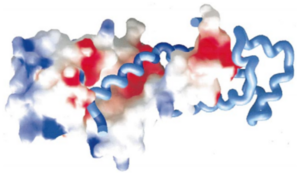Sandbox Reserved 824
From Proteopedia
(Difference between revisions)
| Line 1: | Line 1: | ||
| - | == | + | == Human SRP54 M-domain == |
<StructureSection load='1qb2' size='450' side='right'caption='Dimer of human SRP54M, (PDB code [[1qb2]]) ' scene='56/568022/Hsrp54m_dimer/1' > | <StructureSection load='1qb2' size='450' side='right'caption='Dimer of human SRP54M, (PDB code [[1qb2]]) ' scene='56/568022/Hsrp54m_dimer/1' > | ||
| + | == Context == | ||
SRP54 is a 54kDa cytosolic protein part of the Signal Recognition Particle (SRP). | SRP54 is a 54kDa cytosolic protein part of the Signal Recognition Particle (SRP). | ||
SRP54 bacterial homologous can be referred to as Ffh (Fifty Four Homologous). | SRP54 bacterial homologous can be referred to as Ffh (Fifty Four Homologous). | ||
SRP is a ribonucleoprotein particle essential for the translation and integration in membranes of signal peptide-bearing proteins. SRP is composed of an RNA backbone, on which bind different proteins. | SRP is a ribonucleoprotein particle essential for the translation and integration in membranes of signal peptide-bearing proteins. SRP is composed of an RNA backbone, on which bind different proteins. | ||
| - | For example Mammalian SRP are formed of the RNA 7S and | + | For example Mammalian SRP are formed of the RNA 7S and SRP 9-14-19-54-68-72. |
SRP54 and regions of RNA 7S are highly conserved in every organism and it was found that these two components are sufficient to form a minimal SRP. | SRP54 and regions of RNA 7S are highly conserved in every organism and it was found that these two components are sufficient to form a minimal SRP. | ||
The role of SRP is to : | The role of SRP is to : | ||
| Line 13: | Line 14: | ||
SRP54 is a 504 aminoacids protein,composed of 3 domains: | SRP54 is a 504 aminoacids protein,composed of 3 domains: | ||
| - | + | *N-terminal domain with 4 alpha-helices; | |
| - | + | *G domain, central, with a GTPase activity | |
| - | + | *M domain ( for Methionin Rich). | |
The 1QB2 structure is the M-domain of the human SRP54. It includes the aminoacids 322 to 441. | The 1QB2 structure is the M-domain of the human SRP54. It includes the aminoacids 322 to 441. | ||
| Line 24: | Line 25: | ||
SRP54M is a 120 aminoacids long polypeptide. 1QB2 is a <scene name='56/568022/Hsrp54m_dimer/1'>dimer of SRP54M</scene>, since the studied polypeptide has the interesting property to dimerize in solution. | SRP54M is a 120 aminoacids long polypeptide. 1QB2 is a <scene name='56/568022/Hsrp54m_dimer/1'>dimer of SRP54M</scene>, since the studied polypeptide has the interesting property to dimerize in solution. | ||
| - | Note : in a readability purpose the structures enlighten in the Jmol applet will focus only on one SRP54. The same structures are present in the second SRP54M of the dimer. | + | ''Note : in a readability purpose the structures enlighten in the Jmol applet will focus only on one SRP54. The same structures are present in the second SRP54M of the dimer.'' |
| - | The secondary structure of Hsrp54M is formed of <scene name='56/568022/Hsrp54m_h1_to_h7/1'>7 alpha helixes (H1 to H7)</scene>.The helices 2 to 7 form the <scene name='56/568022/Hsrp54m_core_and_h1v2/1'>Core structure</scene>, stabilized by hydrophobic, hydrogen and ionic interactions. | + | The secondary structure of Hsrp54M is formed of <scene name='56/568022/Hsrp54m_h1_to_h7/1'>7 alpha helixes (H1 to H7)</scene>. The helices 2 to 7 form the <scene name='56/568022/Hsrp54m_core_and_h1v2/1'>Core structure</scene>, stabilized by hydrophobic, hydrogen and ionic interactions. |
| - | Several residues important to maintain the Core structure were identified. | + | Several residues important to maintain the Core structure were identified. Among them the <scene name='56/568022/Hsrp54m_core_and_h1/2'>Methionine 382,Glutamine 386, Arginine 402 and Arginine 405.</scene> |
| - | Among them the <scene name='56/568022/Hsrp54m_core_and_h1/2'>Methionine 382,Glutamine 386, Arginine 402 and Arginine 405.</scene> | + | |
Met382 is invariable while Glu386, Arg402 and Arg405 are well-conserved but not systemically found in the SRP54M of different organisms. | Met382 is invariable while Glu386, Arg402 and Arg405 are well-conserved but not systemically found in the SRP54M of different organisms. | ||
| Line 48: | Line 48: | ||
Theses similarities might come from the fact that the H1 helix is near the hydrophobic groove of its own SRP54M, and that conformational changes (in a full SRP54 protein) might bring H1 into the groove in order to protect it from solvent interaction in the absence of signal peptide. | Theses similarities might come from the fact that the H1 helix is near the hydrophobic groove of its own SRP54M, and that conformational changes (in a full SRP54 protein) might bring H1 into the groove in order to protect it from solvent interaction in the absence of signal peptide. | ||
| - | It was therefore | + | It was therefore hypothesized that the binding of H1 into the groove of another SRP54M provides a possible model of the interaction between the signal peptide and SRP54M in vivo. |
It also explains the dimerization of SRP54M in solution. | It also explains the dimerization of SRP54M in solution. | ||
Revision as of 20:17, 8 January 2014
Human SRP54 M-domain
| |||||||||||
| This Sandbox is Reserved from 06/12/2018, through 30/06/2019 for use in the course "Structural Biology" taught by Bruno Kieffer at the University of Strasbourg, ESBS. This reservation includes Sandbox Reserved 1480 through Sandbox Reserved 1543. |
To get started:
More help: Help:Editing |
Scènes à intégrer

